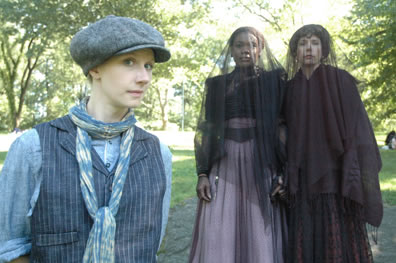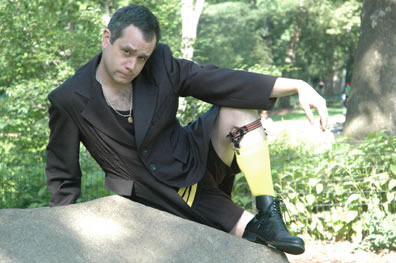Twelfth Night
The Play’s the Thing
Emerging from the Landscape
New York Classical Theatre, Central Park, New York, N.Y.
Saturday, June 9, 2012 (wherever we could alight, scene to scene)
Directed by Stephen Burdman
You’ll get your exercise watching a production by the New York Classical Theatre—stand up, walk over there, sit down, do it again—but the staging is as magical as the text. This really is Shakespeare in the park, played on the lawns, amid the trees, and by the ponds in New York’s Central Park (the company also stages strolling versions of its plays on The Battery).

Viola (Ginny Myers), left, pays her first visit to Olivia (Chantal Jean-Pierre), center, as Maria (Laura J. Cole), looks on in the New York Classical Theatre's production of Twelfth Night playing on the lawns of Central Park. Photo by New York Classical Theatre.
Given this, you would think that nature is the true star, or maybe the large number of children—toddlers to teens—scampering from scene to scene to get the best seats (on the ground), or the intrigued passersby watching from their stopped bicycles. However, just as it takes a magician for us to see magic happen, it takes good actors for us to see Shakespeare magic happen, and this troupe is as good as any (and better than many) gracing the boards of New York’s theaters, indoor and out. Despite the setting and format, this was not a novelty act—the play is still the thing.
Beautifully costumed by production designer Amanda Bujak in late Victorian tails, gowns, and street urchin vests and knee britches (and Malvolio ending up in a classic one-piece swimsuit), the actors played their parts with no extra-textual conceptualizing. As such, this was a delightful comedy with beautifully powerful poetry and a proper dose of pathos. The only interpolations of the text were those necessitated by the staging: “Turn around, mates” the sea captain says, or “Head down the hill” Toby tells us. After Orsino sends Viola (Ginny Myers Lee) on her first mission to Olivia , Lee says, “I’m not dong this alone; you all are coming with me,” and after passing through the crowd she leads us down a path to another lawn. Another textual change is Maria (Laura J. Cole), after the plot on Malvolio takes effect, saying, “The park will be the quieter” instead of the house.
The only nonlocale textual adjustment was to have Fabian appear in the night revelry scene along with Feste. As the latter leaves after Malvolio’s departure, Maria’s instructions for the plot against Malvolio have been amended for Fabian “to make a third” rather than the fool—a fix to Shakespeare’s seeming oversight.
While the cast is solidly competent in playing the verse, the more intriguing art is in playing the spaces. Director Stephen Burdman not only guided the cast in developing their characters and working out blocking, he knew how to perfectly utilize the park’s topography. The box tree scene uses real trees, for example. We see Sebastian (Ben Charles) and Antonio (Danny Randerson) strolling down the path, deep in conversation and, as they come nearer—Sebastian determining to leave Antonio’s company—their talk bursts upon us. Andrew Aguecheek (Ian Antal) can be seen relieving himself at a tree as we approach for the revelry scene, and Toby's noticing him kicks off the hijinks. Walking up a hill at the transition between scenes, Aguecheek sees Sebastian walking away down one path as Viola approaches on another—a comical moment of confusion.

Sean Hagerty as Malvolio donned a classic baithing suit for his yellow-stocking, cross-gartered scene in New York Classical Theatre's produciton of Twelfth Night. The company utilized their Central Park locale well, incorporating trees, hills, and, in this case, rocks in its blocking. Photo by New York Classical Theatre.
The environment also serves up more surprises than a normal theater space would, especially if you are concentrating on the dialogue and characters in front of you. Feste (Andy Patterson) opens the performance, singing and playing on a mandolin, and suddenly Orsino (Daniel Patrick Smith) is there speaking the opening line, “If music be the food of love, play on.” He had to get there via a long walk over the lawn, but so rapt are we on Feste we don’t notice him until he speaks. It instantly transports us into the time of the play, and we are sharing space with the Count Orsino circa 1875. Malvolio (Sean Hagerty), sent by Olivia (Chantal Jean-Pierre) to “return” Viola’s ring, starts on his errand by passing through the audience, sternly ordering us to part so he could pass. This set up his sudden appearance to the night revelers, approaching them from behind the audience. When the stern steward suddenly steps over my outstretched feet, I am as startled as Maria—who screams upon seeing Malvolio suddenly before her—and I'm expecting him to round on me, too.
Where ingenuity uses the landscape to enhance the play, ingenuity is also called upon to make viable those scenes written specifically for the theater. With no trap door in any Central Park lawn (that we know of), the company plays the mad scene with Malvolio blindfolded and bound in a rope held by Toby Belch (John Michalski). As Feste addresses Malvolio, first as Sir Topaz, then as himself, Toby, Maria, and Fabian (Nick Salamone) echo the last words of each line as if they were in a chamber. Seeing Malvolio in these straits helps build sympathy for the steward, especially as Hagerty’s Malvolio is so completely gulled by the letter. The mad scene was still funny, though, and the only departure from the play’s overall comic tone came in the last scene when Malvolio violently grabs hold of Feste. The moment revealed a true rivalry between Olivia’s steward and fool, the former obviously galled by the affection rendered on the latter. Malvolio’s threat of revenge “on the whole pack” of them is in earnest, and Olivia (Chantal Jean-Pierre) took it so. But as Feste leads the actors into singing “The Rain It Raineth Every Day,” Hagerty rejoins them to re-establish a festive mood to send us on our way.
From Antal’s high leg kicks as the capering Aguecheek to Hagerty’s Malvolio struggling to interpret the fake letter as being intended for him, every single actor reveals the depths of Shakespeare’s characters without resorting to caricature. Michalski’s Belch struggles with his sense of romanticism; he has a thing for Maria, but in the night revelry he doesn’t want to hear a love song (though he soon joins in the singing of it). Lee’s Viola wars with her situation while bravely maintaining her public humor. Even as the frightened girl in the faux duel with Aguecheek, she is heroic. And dressed as Cesario, she is a mirror image to Charles’ Sebastian; I bet the cyclist who stops midplay is probably just as confused as the characters in the play.
With kudos to the entire cast, here’s a particular shout-out to two in this particular performance: Peter Martin filling in as Valentine as Smith stepped up from Valentine into Orsino’s formal gray suit to take over for Clay Storseth, who had a family emergency. Both Martin and Smith carried their scripts but never opened them in front of the audience, and both still attained the high level of competence displayed by the rest of the cast.
Combining this skilled cast with Central Park’s landscape, New York Classical Theatre makes Shakespeare a fun adventure with payoffs every step of the way.
Eric Minton
June 15, 2012
Follow Up
After its run in Central Park this production moved to Battery Park, starting and ending at Castle Clinton, at the southern tip of Manhattan, and we caught the July 3 presentation.

Ian Antal as Sir Andrew Aguecheek holds up his challenge to Cesario. Photo courtesy of New York Classical Theatre.
The production hasn’t changed, but the new stage, as it were, offers a different dimension. The players emerge out of (and exit into) the early evening Battery Park strollers, and Sebastian and Antonio arrive in Illyria with the New York Harbor and Statue of Liberty in the background. That’s cool. Unfortunately, Viola and the Sea Captain didn’t also emerge from the harbor, a missed opportunity that came with starting the play at the front entrance of Castle Clinton rather than the side. The gulling scene takes place in the huge East Coast War Memorial, with Malvolio holding forth underneath a giant bronze eagle and the conspirators hiding behind the giant memorial pylons.
Clay Storseth has taken back the role of Orsino from Daniel Patrick Smith, who returned to his original role as Valentine. Some of the players have further developed their parts; Ian Antal is an even zanier Aguecheek than he was before, and Sean Hagerty has deepened his Malvolio’s malevolence, and his reading of the letter has become a true tour de force moment—the drunk bum sitting on the memorial’s side wall stopped cackling like a hyena and departed in a miff when he realized he couldn’t compete with Hagerty’s Malvolio for the crowd’s attention. Despite the need to play big in this environment, Hagerty still manages to give a nuanced performance, from the way he accidently unseals the letter to his making out the words as if reading them for the first time, from his mouthing “M.O.A.I.” to shape them into “Malvolio” to his pronunciation of “and” as “n” to nail Shakespeare’s most obscene pun.
I also clued into a piece of business in the gulling I don’t remember noting in the Central Park outing (or in any other production of Twelfth Night). As Malvolio reads the instructions for dressing in yellow stockings and cross-gartered, Toby Belch and Fabian behind him start snickering while Aguecheek looks puzzled. Obviously, there is a history concerning Malvolio’s yellow stockings and cross gartering of which all of Olivia’s household—save for the self-centered steward—is aware. Nice touch.
No matter the stage, the play is still the thing with this production, and the players who play it so well.
July 8, 2012
Comment: e-mail editorial@shakespeareances.com
Start a discussion in the Bardroom



 Find additional Shakespeareances
Find additional Shakespeareances